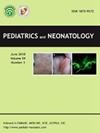Predictive factors of progression to chronic glomerulonephritis in pediatric patients with post streptococcal acute glomerulonephritis
IF 2.3
4区 医学
Q2 PEDIATRICS
引用次数: 0
Abstract
Background
Post streptococcal acute glomerulonephritis (PSAGN) patients have favorable prognosis, in which most patients showed full recovery in terms of kidney function. However, there is a slight chance ranging from 3 to 6% that PSAGN patients develop chronic kidney diseasewhich may progress into end-stage kidney disease in later life. It is important to identify the factors that can predict the development of chronic glomerulonephritis following PSAGN. Therefore, early intervention can be performed to halt the progression of chronic kidney disease. This study aimed to determine the predictive factors of chronic glomerulonephritis in pediatric patients with PSAGN.
Methods
This study was an analytical observational study with retrospective cohort design. The accessible population was children within the age of 2–18 years old who were admitted with PSAGN between January 2015 and December 2020 in Dr. Sardjito General Hospital Yogyakarta. All anonymized patient data were evaluated for demographic variables, clinical features, laboratory profiles and outcome. Multivariate analysis was performed with multivariate logistic regression method.
Results
A total of 124 patients with PSAGN were obtained from medical record data. There were 65 patients (52.4%) with chronic glomerulonephritis. Bivariate analysis was performed on assumed predictive factors with the results indicating massive proteinuria with hypoalbuminemia (OR 1.670, 95%CI 1.199–2.326; p = 0.003), oliguria (OR 1.517, 95%CI 1.101–2.089; p = 0.028) and macroscopic hematuria (OR 1.647, 95%CI:1.061–2.555; p = 0.013) were significantly higher in the PSAGN group with chronic glomerulonephritis compared to those without. Results of the multivariate logistic regression analysis showed massive proteinuria with hypoalbuminemia (OR 2.896, 95%CI 1.177–7.123, p = 0.021) and macroscopic hematuria (OR 2.457, 95%CI ,1.018–5.933, p = 0.046) would highly predict chronic glomerulonephritis in subjects with PSAGN.
Conclusion
We concluded that massive proteinuria with hypoalbuminemia and macroscopic hematuria are the predictive factors which highly predict chronic glomerulonephritis in PSAGN.
链球菌感染后急性肾小球肾炎儿科患者发展为慢性肾小球肾炎的预测因素。
背景大多数链球菌急性肾小球肾炎(PSAGN)患者预后良好,肾功能完全恢复。然而,PSAGN 患者有 3% 至 6% 的几率发展为慢性肾病,并可能在晚年发展为终末期肾病。确定哪些因素可以预测 PSAGN 后慢性肾小球肾炎的发展非常重要。因此,早期干预可以阻止慢性肾脏病的发展。本研究旨在确定 PSAGN 儿童患者慢性肾小球肾炎的预测因素。研究对象为2015年1月至2020年12月期间在日惹Dr. Sardjito综合医院住院的2-18岁患有PSAGN的儿童。对所有匿名患者数据进行了人口统计学变量、临床特征、实验室特征和结果评估。通过多变量逻辑回归法进行了多变量分析。其中 65 名患者(52.4%)患有慢性肾小球肾炎。对假定的预测因素进行了二元分析,结果显示大量蛋白尿伴低蛋白血症(OR 1.670,95%CI 1.199-2.326;P = 0.003)、少尿(OR 1.517,95%CI 1.101-2.089;P = 0.028)和大镜下血尿(OR 1.647,95%CI:1.061-2.555;P = 0.013)在有慢性肾小球肾炎的 PSAGN 组中明显高于无慢性肾小球肾炎者。多变量逻辑回归分析结果显示,大量蛋白尿伴低蛋白血症(OR 2.896,95%CI 1.177-7.123,p = 0.021)和镜下血尿(OR 2.457,95%CI ,1.018-5.933,p = 0.结论我们得出结论,大量蛋白尿伴低蛋白血症和镜下血尿是高度预测 PSAGN 患者慢性肾小球肾炎的预测因素。
本文章由计算机程序翻译,如有差异,请以英文原文为准。
求助全文
约1分钟内获得全文
求助全文
来源期刊

Pediatrics and Neonatology
PEDIATRICS-
CiteScore
3.10
自引率
0.00%
发文量
170
审稿时长
48 days
期刊介绍:
Pediatrics and Neonatology is the official peer-reviewed publication of the Taiwan Pediatric Association and The Society of Neonatology ROC, and is indexed in EMBASE and SCOPUS. Articles on clinical and laboratory research in pediatrics and related fields are eligible for consideration.
 求助内容:
求助内容: 应助结果提醒方式:
应助结果提醒方式:


